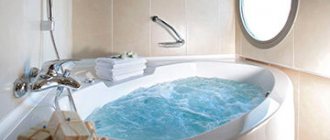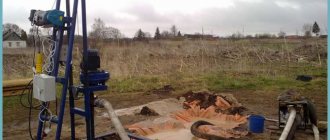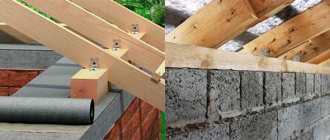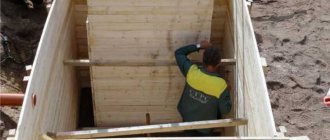High humidity and poor ventilation lead to mold on bathrobes, towels and bathroom trim. To dry things and air in the room, you can use a heated towel rail - a device that is connected to the mains or water coolant.
Most often, the device is installed in a hot water supply or heating riser, so in order to avoid accidents, you must strictly follow the rules for installing a heated towel rail.
What are the benefits of electric heated towel rails?
Electric heated towel rails differ favorably from their water counterparts in that they are not tied to the room - they can simply be unplugged and moved to another room.
To connect an electric heated towel rail, you do not need to connect pipes, install shut-off valves, or ensure that the seals at the connection points are sufficiently tight so that when the hot water is turned off, water does not flow out at the connection points of the heated towel rail. You just need to hang this heating device on the wall and plug it into a power outlet.
Also, as a plus, you can write down the wealth of design solutions of such heated towel rails, which allows you to choose a model that best suits a bathroom in high-tech, Provence, country or modern style.
Operation without installation is a reality
If you do not take into account additional options, then heated towel rails are simply metal tubes welded into a frame with an electrical cable coming out of them, so people often choose EPS, focusing only on its design appearance.
Manufacturing companies take this marketing nuance into account and try to offer consumers original engineering ideas.
The result of the implementation of one of these ideas was a floor-mounted heated towel rail. It does not require installation at all; to turn it on, you just need to plug the device into a power outlet. This option is suitable for bathrooms with a large area and a permanent dry floor area where the device can fit without interference.
It is advisable to carry out a hidden connection of EPS with the participation of specialists who will lay the tiles so that they can suggest the correct location of the fasteners
Wall-mounted electric heated towel rails also have installation features. Some models are equipped with an electrical cable that is built into one of the wall mounts. It is advisable to install such heated towel rails before laying tiles in the bathroom.
Disadvantages of electric heated towel rails
But besides the advantages, such heated towel rails also have their disadvantages. The main one is electricity consumption. And if the operation of a water heated towel rail costs us free, then we will have to pay for the operation of an electric one. Sometimes it turns out to be quite large sums. Another disadvantage is the fact that hot water has never killed anyone, while electric shocks happen all the time. And not all of them end in a successful outcome. This becomes even more relevant in the bathroom, where in a small enclosed space with high humidity we are most often without clothes, standing barefoot on a damp floor, which makes the likelihood of receiving an electric shock in the event of a breakdown on the body of an electrical appliance significantly increases.
Scheme 2
(Bottom connection)
Slightly less effective than the side one, but it has its advantages.
The distance between the bends is any in order to properly weld the pipes and screw on the taps so that their handles do not interfere with each other when rotating. For example, 15-20 centimeters.
Bottom connection of the ladder, operating on natural circulation, without narrowing and without bypass displacement
Bottom ladder connection, operating on a combination of forced and natural circulation, with bypass offset
Bottom connection of the ladder, operating on a combination of forced and natural circulation, with a narrowing of the bypass
Advantages of the scheme:
- Works in any direction of supply in the riser.
- It is possible to install pipes secretly under the bathroom, without cutting into the walls.
Disadvantages of the scheme:
- It is necessary to bleed air through the Mayevsky valves.
- Slightly less efficient compared to side connection.
Conditions for the circuit to work:
- The upper outlet of the riser with an offset or narrowed bypass must be lower than or equal to the bottom of the device. This ensures that the heated towel rail operates independently of the supply direction. With top feed, the top outlet can be located above the bottom edge of the device.
- The lower outlet must be lower than the heated towel rail in all variants of this scheme, so that a dirt trap pit does not form from the supply pipe and the device itself.
Bottom connection (example of conditionally acceptable design)
The bottom of the device is located between the taps. If there is a lower supply in the riser, a low height of the heated towel rail, or a large distance between the taps, this circuit may not work or be unstable.
Internal structure of an electric heated towel rail
The internal structure of electric heated towel rails of different brands is almost the same. In a nutshell, all electric heated towel rails consist of heating elements that heat the coolant that fills the heated towel rail. The coolant can be water, from which oxygen has been completely removed to prevent corrosion, mineral oil, or a solid material - graphite. In modern expensive models of heated towel rails you can find devices for temperature control, timers and program control units. Heated towel rails in the entry-level price range usually only have a plug for plugging into a socket and a switch button. Of course, modern heated towel rails with programmable controls are much more convenient to use.
Required Tools
Before installation, you must ensure that you have all the tools. The presence of certain devices depends on the type of pipes. Taking into account standard steel options, the following equipment is needed:
- gas (number 2), attachment and wrench;
- hacksaw for metal;
- thread-cutting dies;
- electric drill with hammer drill, concrete drills;
- angle grinder (grinder);
- hammer, pliers and screwdriver;
- level, tape measure and pencil.
In addition, you will need a number of consumables:
- bends, bends, couplings, etc.;
- shut-off valves;
- flax tow;
- screws, dowels, bolts and brackets.
Installation instructions for an electric heated towel rail
An electric heated towel rail should be installed in the bathroom strictly following electrical safety rules in wet areas. The installation location must be selected taking into account the degree of protection of the heated towel rail from moisture. In general, it is advisable to adhere to the distances shown in the figure below and choose zone No. 3 to place the electric towel rail (all images are clickable, click to enlarge):
When placed in zone No. 2, the heated towel rail must have splash protection. Approximate distances from the floor and furniture to the electric heated towel rail are shown in the figure below:
1. Adhering to the recommended minimum distances from the floor, walls and curtains, you should attach the electric heated towel rail with its supporting part to the wall and press it. 2. Mark the mounting locations. 3. Depending on the wall material, select the drill and dowels as shown in the picture below:
How to connect and use
- The electrical network to which the heated towel rail is connected must be grounded .
- The load on the radiator cannot exceed 5 kg .
- Do not lean on the device.
- strictly forbidden to disassemble the heated towel rail and its components, as well as make changes .
- Never carry the heated towel rail by the electrical cord .
- It is forbidden to cut the cord and break the seal of the heating element.
- The use of grinding materials leads to loss of shine and scratches on the surface of the product.
- at least once a year .
Connecting an electric heated towel rail to the network
The device must be connected to a permanently installed outlet in accordance with the NFC-15-100 standard.
The heating device should not be located directly under the socket. Connecting the wires to the socket should be carried out strictly in accordance with the factory instructions for the electric heated towel rail, so as not to confuse the phase and neutral. In the junction box, all connections must be carefully made, depending on the presence or absence of a software unit.
The figure below shows the connection diagram for the Campa electric heated towel rail (click to enlarge the image):
Finally about combined dryers
A double-circuit heated towel rail perfectly solves the problem of seasonality when connecting to home heating. During the cold season, the water circuit is heated; at the end of the heating season, you can turn on the second electric coil. The mounting of the device is quite ordinary - on brackets, the connection is made immediately to 2 networks - electrical and heating.
If it is necessary to change the old Soviet coil in an apartment, then the new one does not have to be installed in the same place and connected to the existing fittings. It is very advisable to replace the riser - it is probably “overgrown” with rust. Choose a suitable location for the heater, sketch out the connection diagram and install the heated towel rail according to the new requirements.
Controlling the software unit of an electric heated towel rail
If there is a program block, your heated towel rail can operate in different modes. The settings are shown on the screen (click to enlarge):
Programmable heated towel rails can operate using manually adjusted multi-tariff thermostats. The following functions can be supported:
All modes are set by pressing the corresponding buttons on the control panel. *** As you can see, there is nothing complicated about connecting an electric heated towel rail to the network and installing it on the wall in the bathroom and you can easily perform all the necessary operations yourself.
See also:
Why is the energy saving lamp blinking?
How to connect a shower cabin to the electrical network?
Bathtub grounding
Connecting the washing machine to the mains
Rules for laying electrical wiring in the bathroom
- <How to connect a shower cabin to the power supply?
- Rules for laying electrical wiring in the bathroom>
Popular manufacturing companies
Which manufacturers' products are in greatest demand and respect among buyers?
- "Sunerja". The brand's production is located in St. Petersburg, heated towel rails are manufactured using foreign parts. The company's products are distinguished by their quality and great variety.
- "ARGO". This brand produces all types of heated towel rails, carefully controls quality at all stages and provides a long guarantee.
- "Dvin". The actively developing Russian company has been operating for more than 15 years and produces high-quality heating devices with a wide variety of designs and colors.
- "Nika". A Russian brand specializing mainly in ladder heated towel rails. Stainless steel is used in the manufacture of devices; great attention is paid to the durability and quality of polishing of products.
- Margaroli. The most famous Italian brand, supplying both water and electric models of radiators. Among the advantages of the manufacturer are high quality, elegant design and ease of use of heated towel rails.
- "Grota". The domestic manufacturer offers bathroom radiators of European quality - and pleases customers with a wide variety of design models.
- "Terminus". The brand uses the most innovative technologies in the production of devices and provides a 10-year guarantee - a very long period.
- Energy. The British company is known throughout the world for its wide range of reliable and beautiful bathroom heaters.
Methods of tapping into a riser
Before connecting the heated towel rail to the hot water supply system, a number of preparatory work is carried out. To cut into a vertically located metal hot water supply riser, the following methods are used:
Welding. Often a piece of pipe is cut out in the riser, and tees with threaded elbows and a bypass jumper are welded on top and bottom. If necessary, the bypass is made narrower by one standard size smaller than the main diameter of the riser.
Next, shut-off valves are screwed to the side threaded outlets, from which a polypropylene pipeline is laid to the dryer.
Threaded connections. With this method, a pipe section is cut out of the riser and surface threads are cut using a die on the ends of the cut pipes.
Next, metal tee bends are screwed directly to the threads or through adapter couplings, to which a bypass jumper with double-sided threads and ball valves are in turn connected.
After the shut-off valves, fittings with a metal-plastic transition are placed, to which a polypropylene pipeline is then soldered.
The advantage of this method is the ability to carry out work without a qualified welder and welding machine. True, in return for this you will need a die for cutting threads and the services of a plumber with a soldering iron and experience working with polypropylene.
In addition, this insertion method is quite labor-intensive and is not highly reliable due to the large number of threaded connections. As a result, threads on a cut riser and metal threaded tees are used quite rarely.
Switching to polypropylene. Sometimes, after cutting out the pipe section and threading the ends of the upper and lower pipes, a bypass jumper made of plastic (polypropylene) with pre-soldered side threaded bends for metal is screwed to them. Ball valves and a polypropylene pipeline are in turn connected to their threads.
This technology is used a little more often than the method described above, but its implementation is also associated with certain difficulties when cutting threads on pipes and installing a bypass jumper with tees into their section.
Rice. 11 Examples of inserting dryers into a riser using welding threaded adapters
Clamps. The easiest way to connect a heated towel rail to a pipe is to use overhead saddles or clamps with a threaded outlet.
When installing them, a hole is drilled into the riser pipe, onto which clamps with a sealing gasket are applied and secured by clamping them with bolts and nuts.
Despite the speed and simplicity of this method, it also has a number of significant disadvantages. Fastening the clamps to bolts and nuts is not very reliable and during operation it is possible that they may unscrew themselves. But the main drawback that makes this connection scheme practically unsuitable for use is that the diameter of the hole drilled in the pipe is too small. As a result, the volume of water entering the coil may be insufficient to fully warm it up.
Rice. 12 Examples of connection to a pipeline using clamps and tee couplings Zhebo
Compression fittings. The retail chain sells Zhebo tee couplings, with which you can connect metal pipes and make bends on them.
Types of cable heater
There are two types of heating cable:
Resistive. It has low cost. Quite easy to install. It is usually used in everyday life for heating pipes with a diameter of up to 40 mm and for equipping a heated floor system. The operating principle of this element is to lay special sensors and wires along the entire length of the pipeline. Sensors react to any temperature changes and periodically connect and disconnect the heating system.
The wire can be laid in a spiral or strip method. It is attached to the pipes using aluminum tape. During installation, under no circumstances should you allow it to be over-tensioned. To distribute heat evenly, you can wrap wires and pipes with aluminum foil. You also need a reliable thermal insulation system. Mineral wool is suitable for thermal insulation.
Self-regulating. It is used for heating pipes with a diameter of more than 40 mm, containers, roofs, electrical panels, drains and other things. This heating wire consists of 2 insulated conductors located in a polymer, which, under the influence of temperature changes, changes the resistance. This means that as the air temperature decreases, the resistance of the polymer decreases and the current increases, which leads to an increase in the heat produced. This does not require any temperature controllers or electronic sensors.
If the air temperature rises, then this process goes in the opposite direction. The self-regulating heating cable has a long service life. The cost-effectiveness and safety of the cable is ensured by reliable insulation.
Advantages of self-regulating cables
- A self-regulating cable has a higher resistance to voltage surges. If the voltage is increased for a long time, the cable will not burn out.
- The self-regulating cable can be cut into pieces of the desired size. But resistive ones have a fixed length.
Multi-level floor
To zone the space, craftsmen install floors at different levels. They advise installing a podium to separate the kitchen and dining room. This option is considered one of the most practical because, among other things, the owners have additional free space where they can hide something. It is convenient to use boxes or crates for this. Wicker baskets will look good. But such space can remain free.
However, such a design should not be made if there are small children in the family, since the podium can become an obstacle for him. In addition, various floor coverings can be used. They will zone the space between the living room and the kitchen and protect the podium from damage. For example, tiles are laid in the kitchen area, and laminate flooring in the dining room. The main thing is to choose colors and textures and combine the finishes correctly.











